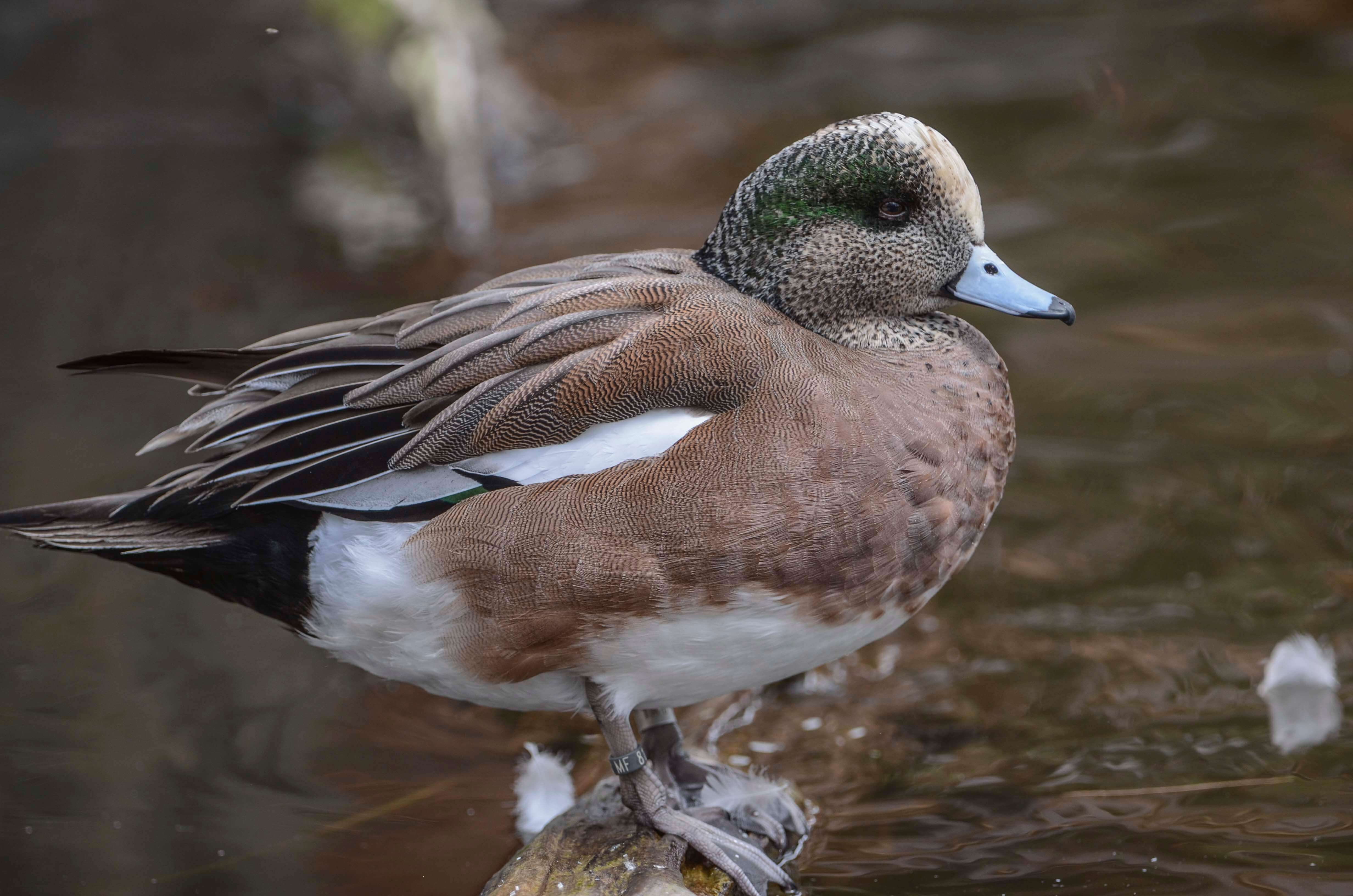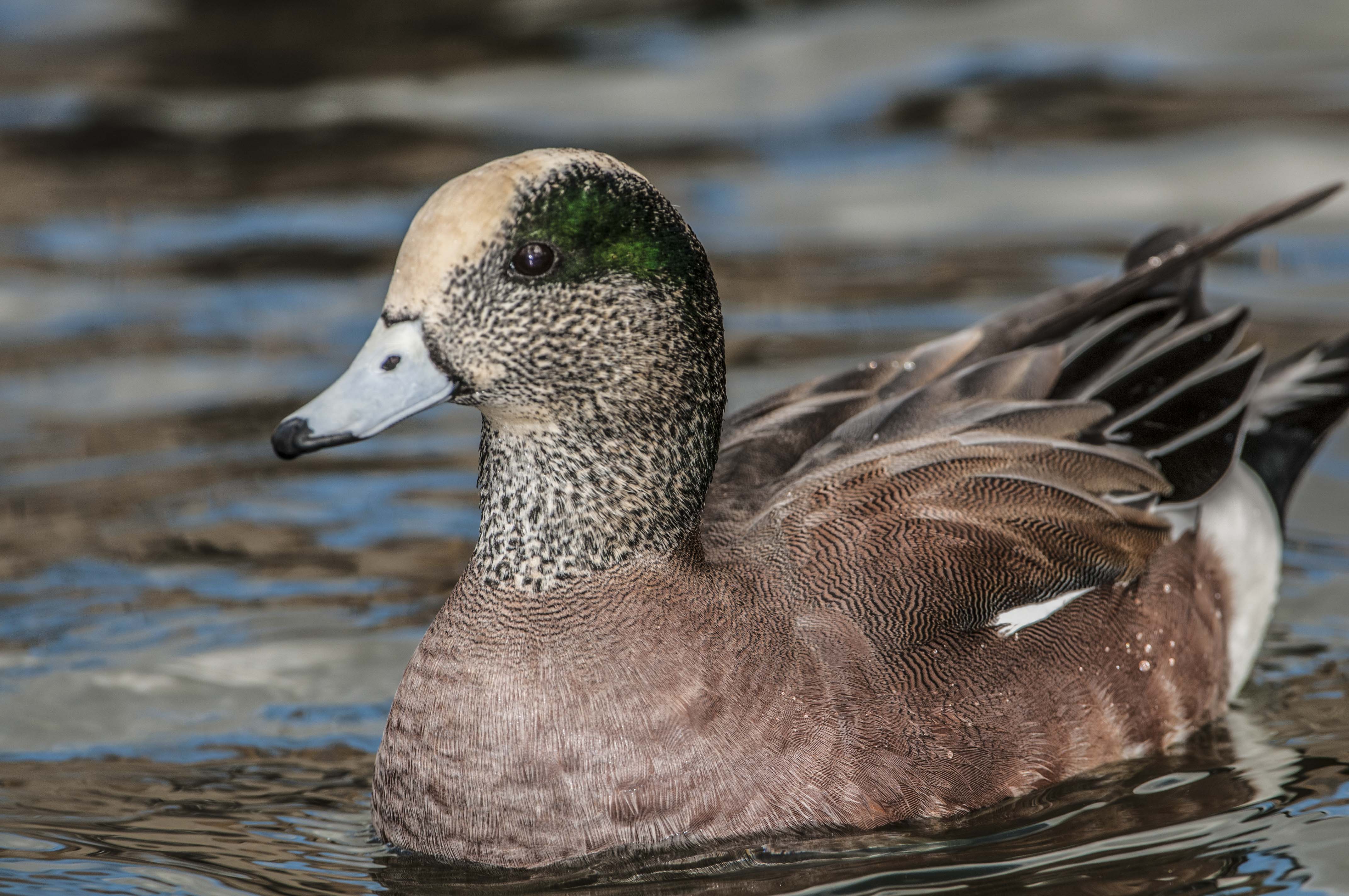American Wigeon
Mareca Americana

The American Wigeon, sometimes spelled widgeon, is a dabbling duck about the size of a mallard. The male is easily recognized during breeding season by his green eyepatch, light blue bill, gray chin and throat, white belly with chestnut sides, black undertail and a white crown, which earns him the nickname, “baldpate”. When in flight, white patches on the upper wing are evident as well. Like many ducks, the female is much more cryptically dressed in browns, grays, and black. She is distinctive though with a smudge around the eye that makes it look like she received a black eye during a “fist fight”. They have a short bill compared to many other ducks. Both sexes tend to sit on the water with heads pulled down, giving the appearance of having no neck.
Behavior and Habitat
Like other dabbling ducks, wigeons are most at home in shallow wetlands of many types. You can also find them gleaning recently harvested fields. They are primarily vegetarian, eating both aquatic and terrestrial plant parts such as seeds, stems and leaves of such plants as cattail, duckweed, water milfoil, wheat, rice and barley. During the breeding season though, they increase their intake of invertebrates. This is particularly true for the females because they need the extra protein for egg production.
The female selects the nest site, often far from water, and constructs a simple grass-lined bowl on the ground in a depression she creates for this purpose. They may have as many as 13 creamy white eggs.
Wigeons are a social bird, often forming large flocks, even during the non-breeding season where they may join mixed-species flocks.
Similar Species
The breeding American wigeon is pretty distinctive, but there are a couple species that might fool you until you look closely. The Eurasian wigeon has a tan pate and a brown head and neck, lacking the green eye patch on males. The green-winged teal has a green eye patch but has a rich brown pate and a white crescent on the wing.
Cool Facts
The wigeon is quite vocal but the two sexes don’t sound at all alike. The male’s call sounds like a child’s squeaky toy while the female sounds more like a raspy crow or jay.
The wigeon’s short, goose-like bill allows them to exert more pressure at the tip than longer-billed cousins. Thus, they can eat a wider variety of plant material and as a consequence eat proportionately more vegetation than any other dabbling duck.
When and where found at Camas NWR
Watch for wigeons on any open water on the refuge. You may also see them in neighboring grain fields.

Conservation
“American Wigeons are common, but their populations declined by 2% per year between 1966 and 2015, according to the North American Breeding Bird Survey, resulting in a cumulative decline of 65% over the 49-year period. Partners in Flight estimates the global breeding population at 1.4 million. The species rates a 10 out of 20 on the Continental Concern Score, which means it is not on the Partners in Flight Watch List and is a species of low conservation concern. The U.S. Fish and Wildlife Service carefully manages duck hunting and limits the number of individuals hunters can take every year based on population size. Hunters took an average of 647,835 American Wigeon per year from 2012-2016. Fluctuations in American Wigeon populations are likely driven by weather and land use changes. In wet years reproduction is usually higher than in drought years. Drought, especially in the prairie pothole region, reduces the amount of nesting habitat, pushing them to nest farther north. Loss and degradation of wetland habitat on the breeding and wintering grounds due to agricultural conversion can also affect survival.”
https://www.allaboutbirds.org/guide/American Wigeon/lifehistory#conservation
Text by Terry Thomas. Source: https://www.allaboutbirds.org
Photos by Terry Thomas.